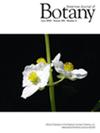Species-tree topology impacts the inference of ancient whole-genome duplications across the angiosperm phylogeny
Abstract
Premise
The history of angiosperms is marked by repeated rounds of ancient whole-genome duplications (WGDs). Here we used state-of-the-art methods to provide an up-to-date view of the distribution of WGDs in the history of angiosperms that considers both uncertainty introduced by different WGD inference methods and different underlying species-tree hypotheses.
Methods
We used the distribution synonymous divergences (Ks) of paralogs and orthologs from transcriptomic and genomic data to infer and place WGDs across two hypothesized angiosperm phylogenies. We further tested these WGD hypotheses with syntenic inferences and Bayesian models of duplicate gene gain and loss.
Results
The predicted number of WGDs in the history of angiosperms (~170) based on the current taxon sampling is largely similar across different inference methods, but varies in the precise placement of WGDs on the phylogeny. Ks-based methods often yield alternative hypothesized WGD placements due to variation in substitution rates among lineages. Phylogenetic models of duplicate gene gain and loss are more robust to topological variation. However, errors in species-tree inference can still produce spurious WGD hypotheses, regardless of method used.
Conclusions
Here we showed that different WGD inference methods largely agree on an average of 3.5 WGD in the history of individual angiosperm species. However, the precise placement of WGDs on the phylogeny is subject to the WGD inference method and tree topology. As researchers continue to test hypotheses regarding the impacts ancient WGDs have on angiosperm evolution, it is important to consider the uncertainty of the phylogeny as well as WGD inference methods.

 求助内容:
求助内容: 应助结果提醒方式:
应助结果提醒方式:


